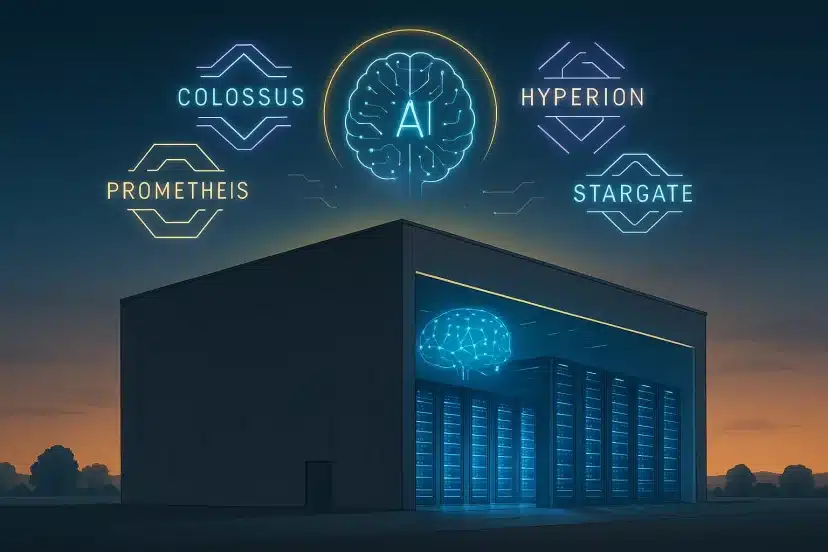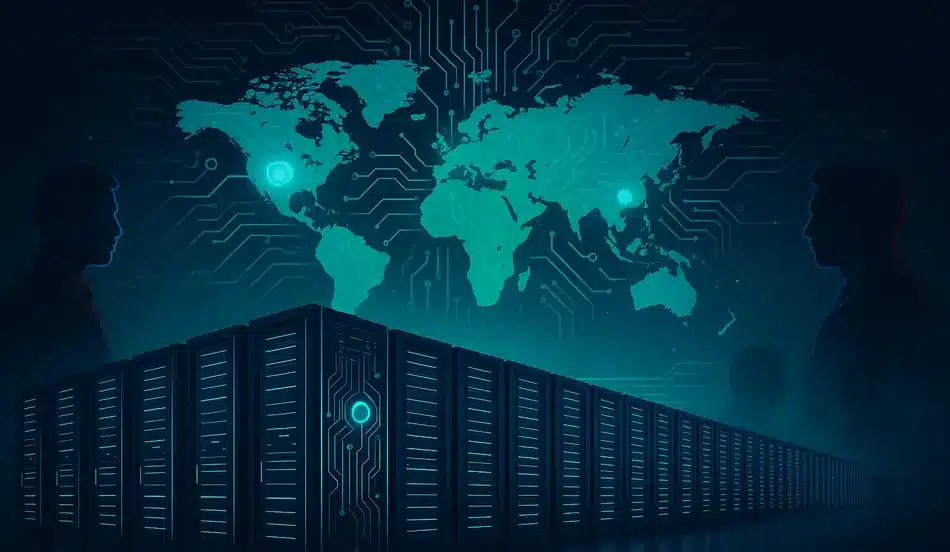When people imagine the world’s biggest construction projects, they often think of massive skyscrapers, high-speed trains, international airports, or pipelines stretching across continents. But in 2025, the most important and most expensive construction projects on Earth involve computers—and not just any computers, but AI supercomputers.
These machines are housed inside data centers—large, plain, windowless buildings that rarely attract attention from the outside. Often they are gray boxes on the edge of cities or deep in rural areas. But inside, these buildings hold the most powerful computer systems ever created. To make them sound less boring, tech companies give their data centers dramatic names: Colossus, Prometheus, Hyperion, Stargate.
Despite their bland appearance, inside these facilities lies the future. These supercomputers are designed to train artificial intelligence systems, and the companies building them believe they will shape the future of the internet, business, and daily life.

A Price Tag Beyond Imagination of AI Supercomputers
The cost of these projects is staggering. The most ambitious is Stargate, led by OpenAI CEO Sam Altman and supported by U.S. President Donald Trump. Stargate’s projected cost is $500 billion.
For comparison:
- The U.S. interstate highway system, stretching across an entire nation, cost about $460 billion (adjusted for today’s money).
- Saudi Arabia’s futuristic city The Line, one of the most ambitious urban projects in history, is priced in a similar range.
That means a single AI data center could cost more than some of the most significant national infrastructure projects in history.
The Energy Challenge
Building a data center is only half the problem. Powering it is just as hard.
A single modern data center can require as much electricity as 400,000 electric cars running nonstop. That means these facilities consume as much energy as a small country. And when computers burn through that much energy, they also generate extreme amounts of heat.
To prevent overheating, data centers require millions of gallons of water each day to keep the machines cool. This puts pressure not only on local power grids but also on local water supplies. Some cities cannot keep up, forcing companies to build their own power plants or import energy from elsewhere.
This raises an urgent question: is America prepared for the energy needs of the AI revolution?
Why Build These Machines?
Supercomputers are not new. For decades, governments and research institutions have used them to solve complex scientific problems. They modeled climate change, decoded human DNA, simulated nuclear reactions, and developed medicines.
They worked by dividing problems into smaller parts and solving them in parallel. Think of a Formula 1 pit crew: a single mechanic could change all the tires on a car, but it would take a long time. With a team of specialists, each person handles one part, and the car is ready in seconds.
Artificial intelligence works in a similar way. Training AI requires running billions of calculations simultaneously. The bigger the supercomputer, the more advanced the AI can become.
Tech leaders believe that with a machine large enough, they might one day reach artificial superintelligence—an AI smarter than humans in almost every way. This concept, often called the singularity, is controversial and may not even be possible. But the road toward it promises enormous profits, which is why the world’s richest men are racing ahead.
Elon Musk’s Colossus
The AI arms race began in 2024 with Elon Musk. His company, xAI, built the world’s largest AI supercomputer, called Colossus, in Memphis, Tennessee.
Inside Colossus are 200,000 Nvidia GPU chips, all linked with fiber optics to form one giant network. It requires 300 megawatts of electricity, equal to the demand of about 300,000 homes. To cool it, Colossus consumes 1–5 million gallons of water per day.
Memphis could not provide enough energy through its grid, so Musk installed 35 natural gas generators in the parking lot just to run the facility.
And Musk has bigger plans. He is already preparing Colossus 2, which will scale up to nearly 1 million GPU chips—five times the current size.
Mark Zuckerberg’s Prometheus and Hyperion
Next in line is Mark Zuckerberg, the founder of Facebook and CEO of Meta. Determined not to fall behind, Zuckerberg has launched two enormous AI data center projects.
- Prometheus – Located in New Albany, Ohio, this data center is described as a multi-gigawatt facility. That means several times more powerful than Musk’s Colossus, which runs at 300 megawatts. Prometheus is expected to be online by 2026.
- Hyperion – Planned for Louisiana, this project will be even bigger. Zuckerberg says the site will cover an area nearly the size of Manhattan Island (23 square miles). Once fully built by 2030, it will consume 5 gigawatts of electricity—enough to power 5 million homes.
Zuckerberg has promised hundreds of billions of dollars in investment, saying Meta will have more computing power per AI researcher than any other company in the world.
The Stargate Project
While Musk and Zuckerberg compete for size, Stargate has captured global attention for its ambition and political backing.
- Location: Abilene, Texas
- Scale: Eight buildings, each with 50,000 GPU chips—for a total of 400,000.
- Power demand: Projected to reach 1.2 gigawatts, equal to the electricity needs of 1 million homes.
Unlike Colossus, which uses Nvidia’s current H100 GPUs, Stargate will be equipped with the next-generation Blackwell B200 chips, which perform about 50% faster.
Construction is moving quickly, with crews working 24/7. The goal is to bring each cluster online one at a time, giving OpenAI more computing power as demand for ChatGPT continues to grow.
Meeting “Biblical” Demand
Sam Altman has spoken openly about the challenges of keeping up with ChatGPT’s popularity. During one viral trend in March 2025, the service was adding 1 million new users every hour. At its peak, ChatGPT had 150 million weekly active users.
Altman described this as “biblical demand.” The company’s servers were stretched so thin that engineers had to redirect resources away from research and even slow down certain features just to keep the system online.
For OpenAI, Stargate is not just about building superintelligence in the future—it is about surviving user demand today.
A Coming Energy Crisis
By 2035, U.S. data centers are projected to consume 8% of the nation’s total electricity supply. But that figure may be conservative, given the massive scale of projects now under construction.
To prepare, tech leaders are investing directly in energy:
- Elon Musk has purchased a foreign power plant to ship to the U.S. piece by piece. He has also bought a natural gas plant and a solar facility in Memphis.
- Mark Zuckerberg signed a 20-year deal to use an entire nuclear reactor in Illinois.
- Sam Altman is backing small modular nuclear reactors, expected to be available by the early 2030s. In the meantime, Stargate will rely on Texas’s abundant wind power and solar farms built by SB Energy, a SoftBank-backed company.
This trend suggests that the AI race is not just about computers—it is also about control of energy infrastructure.
Hire Talent to Power the Future
Post your job on WhatJobs and connect with energy engineers, data center specialists, and renewable energy professionals ready to secure tomorrow’s infrastructure.
Post a Job Now →Why This Matters
The internet reshaped the world in the early 2000s. Smartphones, social media, and streaming platforms changed how people live, work, and communicate.
Artificial intelligence may bring a transformation just as big—or bigger—in the 2030s. Supercomputers like Colossus, Prometheus, Hyperion, and Stargate are the foundation of that future.
But there are serious risks:
- Cost: Hundreds of billions are being spent on projects with uncertain payoffs.
- Energy use: Demand could overwhelm grids and water systems.
- Competition: An AI arms race may push companies to move too fast, leaving regulators unable to catch up.
FAQs
Q: Why do AI data centers use so much electricity?
A: Training and running AI requires billions of calculations every second. Doing this in parallel across hundreds of thousands of chips demands enormous amounts of power.
Q: How much water does a single AI data center use?
A: Between 1 million and 5 million gallons per day, depending on its size. That is enough water to supply tens of thousands of households.
Q: Which supercomputer will be the biggest?
A: Meta’s Hyperion is planned to be the largest by 2030, consuming 5 gigawatts of power—five times more than Stargate’s first phase.
Q: Why are Musk, Zuckerberg, and Altman building these so fast?
A: Meta’s Hyperion is planned to be the largest by 2030, consuming 5 gigawatts of power—five times more than Stargate’s first phase.
Q: Why are Musk, Zuckerberg, and Altman building these so fast?
A: Each wants to dominate the next stage of the AI revolution. The bigger the computer, the more powerful the AI—and the higher the chance of creating systems that could transform industries.
Q: What role is government playing?
A: President Trump has been a vocal supporter of Stargate, calling it a strategic investment in U.S. technology. But critics warn that government and regulators are struggling to keep pace with the speed of private investment.
Conclusion
The richest men in the world have chosen their battlefield: AI supercomputers. From Musk’s Colossus to Zuckerberg’s Hyperion to Altman’s Stargate, the scale of construction and spending is unlike anything the technology world has seen before.
Whether these projects lead to artificial superintelligence or the most expensive failure in history remains to be seen. What is certain is that these data centers will reshape economies, energy systems, and societies for decades to come.
Behind the plain gray walls of these buildings, the future is being written—one calculation at a time.




